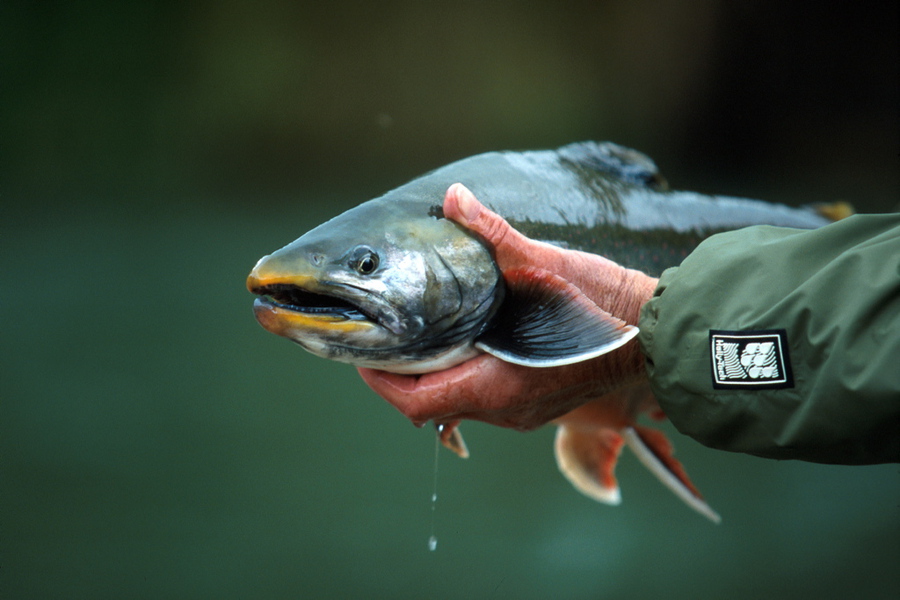
A group of researchers in Canada has retracted their 2018 paper on the gene sequence of the Arctic charr — a particularly hearty member of the Salmonidae family that includes salmon and trout — after discovering that the sample they’d used for their analysis was from a different kind of fish.
The paper, “The Arctic charr (Salvelinus alpinus) genome and transcriptome assembly,” appeared in PLOS ONE, and has been cited 29 times, according to Clarivate Analytics’ Web of Science. Per the abstract:
A single Arctic charr individual (female—inferred from the absence of the male-specific SDY gene in the sequence data set) of approximately 20 cm in length was obtained from Icy Waters Ltd. Tissues (eye, heart, spleen, gut, muscle, brain, hind kidney, head kidney, stomach, gill, liver, and gonad) were dissected from the female and stored in RNAlater (at -80°C) for RNA-seq analysis (see the RNA-seq and gene annotation section for RNA-seq information). The remaining tissues were also stored in RNAlater, and liver from this remaining tissue was used as the primary source for the DNA extraction.
That individual fish came from an area researchers thought was the exclusive territory of Arctic charr and was not home to related species. But that proved to be incorrect.
According to the notice:
After this article [1] was published, further analysis revealed that the sample used for the reported genome analysis was more likely from the closely related species, Dolly Varden (Salvelinus malma), or may have been from a hybrid between the two species. [The Dolly Varden is another member of the Salmonidae family whose lyrical name appears to have come from the similarity of its markings to a style of dress from the 1870s and an eponymous character from a novel by Charles Dickens.]
We stand by the genome and transcriptome assembly as scientifically valid and representative of the sample analyzed. However, the identity of that individual is now in question and consequently the article’s title, results, and conclusions attributing the sequences to Arctic charr are not upheld.
In light of this issue, we retract the article. We have also requested that NCBI change the species name on the genome sequence deposition to indicate that the data were derived from unclassified species in the Salvelinus genus, or Salvelinus sp.
The authors apologize for the issues with this article.
AS and RM either could not be reached or did not respond to correspondence about this retraction. The other authors all agreed with the retraction decision.
Ben Koop, a professor and Canada Research Chair of Biology at the Centre for Biomedical Research at the University of Victoria, and the senior author of the paper, told us:
The retraction came as a result of species misidentification where the two species interbreed. The high arctic remote location sampled by a collaborator was thought to be outside the range of S. malma and well within the range of S. alpinus. As it turns out in this region, S. malma does occur and at the edge of its range interbreeds with S alpinus. We had called the genome sequence S alpinus when upon further study in collaboration with others, we identified the reference genome sequence as a hybrid with mostly S malma genetic background. As such, while the data remains a useful resource for both S malma and S alpinus we could no longer call the reference genome either S malma or S alpinus.
Like Retraction Watch? You can make a tax-deductible contribution to support our work, follow us on Twitter, like us on Facebook, add us to your RSS reader, or subscribe to our daily digest. If you find a retraction that’s not in our database, you can let us know here. For comments or feedback, email us at [email protected].
Fundamental problem is submitting and publishing a paper based on *one* specimen, when multiple specimens could easily have been used! This is typology taken to an extreme. If the authors had sampled the genome of multiple individuals, from more than one locality, they would have realized that the original specimen was misidentified and/or a species hybrid.
Also, even if the original specimen was correctly identified, studying multiple specimens from several localities could have led to interesting observations on variation within the species.
“This is typology taken to an extreme.” No, not at all. One goal of research like this is to generate a reference genome. That reference is almost always made from a single individual if possible. One reason for that is to help in describing the structure and contents of that single genome or the expression of its genes (in the transcriptomes). That description is harder to do if the reference genome has a lot of genetic variation within it (e.g., because it was constructed from data for many genetically different individuals).
Then the reference genome is used as a tool to assemble sequence data collected from other individuals. It can be used to do the followup study you suggested of genetic variation among individuals or localities (or for lots of other applications).
But making the reference genome and describing its gene content, structure, and expression is the first step. That’s all this paper meant to do. Misidentifying that fish was an error but it’s not extreme typology.
Concur, that’s a awful lot of analysis and interpretation to hang on a single fish obtained from a fish farm. I didn’t even know it was possible to buy a single fish from a fish wholesaler.
More interesting to me are the 2 of 14 authors that didn’t agree to the retraction because they didn’t respond to emails. Makes one wonder how engaged they were in the first place.